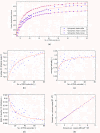Molecular dynamics simulations on aqueous two-phase systems - Single PEG-molecules in solution
- PMID: 22873343
- PMCID: PMC3469337
- DOI: 10.1186/2046-1682-5-14
Molecular dynamics simulations on aqueous two-phase systems - Single PEG-molecules in solution
Abstract
Background: Molecular Dynamics (MD) simulations are a promising tool to generate molecular understanding of processes related to the purification of proteins. Polyethylene glycols (PEG) of various length are commonly used in the production and purification of proteins. The molecular mechanisms behind PEG driven precipitation, aqueous two-phase formation or the effects of PEGylation are however still poorly understood.
Results: In this paper, we ran MD simulations of single PEG molecules of variable length in explicitly simulated water. The resulting structures are in good agreement with experimentally determined 3D structures of PEG. The increase in surface hydrophobicity of PEG of longer chain length could be explained on an atomic scale. PEG-water interactions as well as aqueous two-phase formation in the presence of PO4 were found to be correlated to PEG surface hydrophobicity.
Conclusions: We were able to show that the taken MD simulation approach is capable of generating both structural data as well as molecule descriptors in agreement with experimental data. Thus, we are confident of having a good in silico representation of PEG.
Figures








Similar articles
-
Hybrid Atomistic and Coarse-Grained Molecular Dynamics Simulations of Polyethylene Glycol (PEG) in Explicit Water.J Phys Chem B. 2016 May 5;120(17):4160-73. doi: 10.1021/acs.jpcb.6b02327. Epub 2016 Apr 25. J Phys Chem B. 2016. PMID: 27108869
-
Molecular dynamics simulations approach for the characterization of peptides with respect to hydrophobicity.J Phys Chem B. 2014 Feb 20;118(7):1707-14. doi: 10.1021/jp407390f. Epub 2014 Feb 7. J Phys Chem B. 2014. PMID: 24506060
-
Raman spectroscopy and molecular dynamics simulations of aqueous two-phase systems for the purification of phosphoric acid.Phys Chem Chem Phys. 2023 Nov 29;25(46):31907-31916. doi: 10.1039/d3cp04084d. Phys Chem Chem Phys. 2023. PMID: 37971686
-
Purification of pegylated proteins.Methods Biochem Anal. 2011;54:339-62. doi: 10.1002/9780470939932.ch14. Methods Biochem Anal. 2011. PMID: 21954785 Review.
-
Aqueous two-phase systems for protein separation: a perspective.J Chromatogr A. 2011 Dec 9;1218(49):8826-35. doi: 10.1016/j.chroma.2011.06.051. Epub 2011 Jun 21. J Chromatogr A. 2011. PMID: 21752387 Review.
Cited by
-
Optimizing PEGylation of TiO2 Nanocrystals through a Combined Experimental and Computational Study.Chem Mater. 2019 Sep 24;31(18):7531-7546. doi: 10.1021/acs.chemmater.9b02329. Epub 2019 Aug 9. Chem Mater. 2019. PMID: 31875864 Free PMC article.
-
R-Type Fonticins Produced by Pragia fontium Form Large Pores with High Conductance.J Bacteriol. 2023 Jan 26;205(1):e0031522. doi: 10.1128/jb.00315-22. Epub 2022 Dec 21. J Bacteriol. 2023. PMID: 36541812 Free PMC article.
-
Hydrocarbon-Based Statistical Copolymers Outperform Block Copolymers for Stabilization of Ethanol-Water Foams.ACS Appl Mater Interfaces. 2022 Aug 31;14(34):39548-39559. doi: 10.1021/acsami.2c09910. Epub 2022 Aug 19. ACS Appl Mater Interfaces. 2022. PMID: 35984897 Free PMC article.
-
Multiphoton lithography with protein photoresists.Mater Today Bio. 2024 Feb 10;25:100994. doi: 10.1016/j.mtbio.2024.100994. eCollection 2024 Apr. Mater Today Bio. 2024. PMID: 38384793 Free PMC article.
-
Rapid and inexpensive purification of adenovirus vectors using an optimised aqueous two-phase technology.J Virol Methods. 2022 Jan;299:114305. doi: 10.1016/j.jviromet.2021.114305. Epub 2021 Oct 6. J Virol Methods. 2022. PMID: 34626684 Free PMC article.
References
-
- Atha DH, Ingham KC. Mechanism of precipitation of proteins by polyethylene glycols. Analysis in terms of excluded volume. J biol Chem. 1981;256(2323):12108–17. - PubMed
-
- Albertsson PÅ. Particle fractionation in liquid two-phase systems The composition of some phase systems and the behavior of some model particles in them application to the isolation of cell walls from microorganisms. Biochim Biophys Acta. 1958;27:378–395. - PubMed
-
- Hansson UB, Wingren C. Separation of antibodies by liquid-liquid aqueous partition and by liquid-liquid partition chromatography. Sep Purif Methods. 1998;27(2):169–211. doi: 10.1080/03602549809351640. - DOI
LinkOut - more resources
Full Text Sources
Other Literature Sources
Miscellaneous

